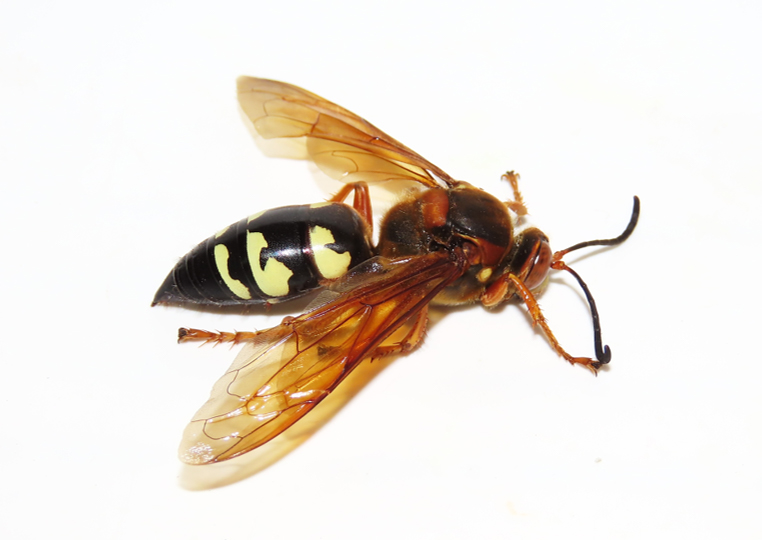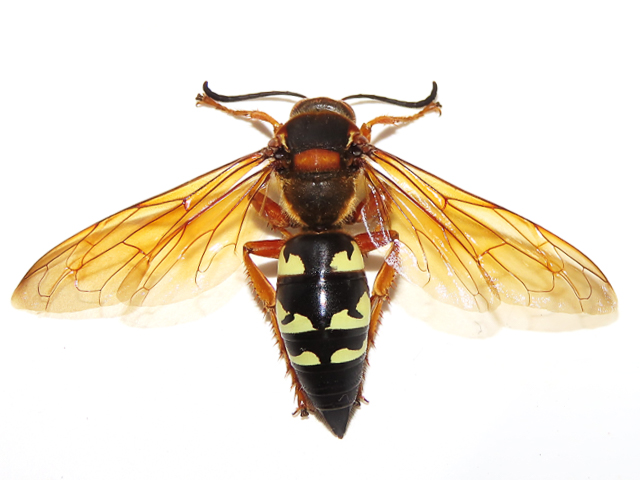Nature Now! Cicada Killers
For immediate release ‐ August 12, 2021
Contact: Micah Beasley, 919.707.9970. Images available upon request

Cicada Killer (Sphecius speciosus). Photo: Jeff Beane/NCMNS.
By Colin A. Brammer, PhD, Coordinator of the Natural World Investigate Lab
Late in the summer you may see sleek black and yellow creatures hovering over a patch of earth and possibly burrowing into it. Don’t worry! The Eastern Cicada Killer, Sphecius speciosus, is one of five species of large solitary wasps of the Family Crabronidae found in the New World that specialize in preying on, you guessed it, cicadas.
Cicada Killers primarily hunt the annual (emerging every year) cicadas but will also go after the periodical cicadas when they make their appearance. The female Cicada Killer will locate a cicada, sting it to paralyze it, then drag it back to the burrow which she had meticulously excavated. Although the female Cicada Killer is quite large, some of the cicada prey are heavier than she is, so the female tends to climb up surfaces like trees or fences with her prey, and then glide to the ground repeatedly until she reaches her burrow.
Development of Cicada Killers starts with an egg laid by a female on a paralyzed cicada that has been placed in a burrow. When the larva hatches from the egg, it starts feeding on the immobile, cicada. The larva will go through five instars (molts) as it grows. When the larva has finished its cicada feast, it will then pupate, going through the third phase of its complete lifecycle. During this time, it is developing into an adult. When the time is right, the adult will burrow out of the ground and start the cycle anew.
They live approximately two months as adults. During this time, the males try to find a female, while the females continually hunt for, and capture, cicadas to provision their burrows and feed their young.

Cicada Killer (Sphecius speciosus). Photo: Jeff Beane/NCMNS.
Often people will think they are being ‘attacked’ by a cicada killer in their front yard, but this is just the male putting on a show. Male Cicada Killers, like all male insects, do not have a stinger (the modified ovipositor). Males are flying in an ‘aggressive’ pattern marking their territory against potential predators and other male Cicada Killers. Fear not, even if one of these were to buzz by you, it is as harmless as a duckling.
Many people feel trepidation when seeing Cicada Killers, but they are solitary and pretty harmless unless you happen to be a cicada. Being solitary, the female is interested in capturing cicadas for her young to feed on, not stinging people. She does not want to take the risk of being injured in a fight and would rather fly away safely when confronted. Females will only sting as a last resort to being inescapably trapped. So don’t try grabbing any of these wasps when you see them (as if you would need that reminder).
Many times I am asked about the holes that Cicada Killers make in a yard to build their burrows. People often think the insects are doing damage to the lawn, or causing unsightly holes in their otherwise pristine yard. Don’t kill them! Not only are they a valuable and important part of the local ecosystem, they’re helping with free lawn aeration.
For more information about our upcoming activities, conservation news and ground-breaking research, follow @NaturalSciences on Instagram, Twitter and Facebook. Join the conversation with #visitNCMNS.

